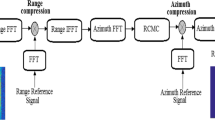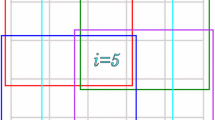Abstract
The existing spatially variant apodizations (SVAs) either cannot depress the sidelobes effectively or reduce the energy of the mainlobe. To improve this, a modified SVA (MSVA) is put forward in this paper, which expands the traditional filter from 3-taps to 5-taps and sets relevant parameters according to different sampling rates to get the excellent result that satisfies constrained optimization theory. A method for synthetic aperture radar (SAR) sidelobe control based on MSVA is presented, which applies MSVA to range compression and azimuth compression to control sidelobes. This method which is available for any Nyquist sampling rate can both depress the sidelobes effectively and keep the energy of the mainlobe and the resolution of the image. The method can reduce sidelobe levels more effectively than classical amplitude weighting while maintaining the image resolution, as demonstrated by the result of the experiment.
Similar content being viewed by others
References
Cumming I G, Wong F H. Digital Processing of Synthetic Aperture Radar Data: Algorithms and Implementation. Norwood: Artech House, Inc., 2005
Nuttall A H. Some windows with very good sidelobe behavior. IEEE T Acoust, Speech, Signal Proc, 1981, 29: 84–91
Zhang X Y, Su W M, Shi J, et al. Application of apodization filtering sidelobe suppression technique to synthetic aperture radar. J Electron & Inform Tech, 2008, 30: 902–905
Kwan H K, Lee C K. A neural network approach to pulse radar detection. IEEE T Aero Electron Syst, 1993, 29: 9–21
Stankwitz H C, Dallaire R J, Fienup J R. Spatially variant apodization for sidelobe control in sar imagery. In: Record of the 1994 IEEE National Radar Conference, 1994. 132–137
Stankwitz H C, Taylor S P. Super-resolution for SAR/ISAR RCS measurement using spatially variant apodization (Super-SVA). In: Antenna Measurement Techniques Association 17th Annual Meeting & Symposium, The Williamsburg Lodge, 1995. 251–256
Stankwitz H C, Kosek M R. Sparse aperture fill for sar using super-SVA. In: Proceedings of 1996 IEEE Radar Conference, Ann Arbor, MI, 1996. 70–75
Castillo-Rubio C, Romano S L, Burgos-Garcia M. Spatially variant apodization for squinted synthetic aperture radar images. In: IEEE Transactions on Image Processing, 2007. 16: 2023–2027
Zhai W S, Zhang Y H. Apply spatially variant apodization to SAR/INSAR image processing. In: 1st Asian and Pacific Conference on Synthetic Aperture Radar, Huangshan, China, 2007. 54–57
Xu X J, Narayanan R M. Enhanced resolution in SAR/ISAR imaging using iterative sidelobe apodization. IEEE T Image Proc, 2005, 14: 537–547
Fischer J, Pupeza I, Scheiber R. Sidelobe suppression using the SVA method for SAR images and sounding radars. In: 6th European Conference on Synthetic Aperture Radar (EUSAR 2006), Dresden, Germany, 2006
Stankwitz H C, Dallaire R J, Fienup J R. Nonlinear apodization for sidelobe control in SAR imagery. IEEE T Aeros Electr Syst, 1995, 31: 267–279
Smith B H. Generalization of spatially variant apodization to noninteger nyquist sampling rates. IEEE T Image Proc, 2000, 9: 1088–1093
Castillo-Rubio C, Romano S L, Burgos-Garcia M. Robust SVA method for every sampling rate condition. IEEE T Aeros Electr Syst, 2007, 43: 571–580
Hu L J, Sun X J. MATLAB Mathematical Experiment. Beijing: Higher Education Press, 2006
Jiang Q Y, Xing W X, Xie J X, et al. Experiments in Advanced Mathematics. Beijing: Tsinghua University Press, 2005
Cheng Y P, Lu Y L, Lin Z P. A super resolution SAR imaging method based on CSA. In: Geoscience and Remote Sensing Symposium (IGARSS’ 02), 2002. 6: 3671–3673
Rancy R K, Runge H, Bamler R, et al. Precision SAR processing using chirp scaling. IEEE T Geosci Remote Sens, 1994, 32: 786–799
Ji H B, Wang Y D, Wu Y R, et al. A modified apodization method in SAR/ISAR processing. IGARSS2003, Toulouse, France, 2003. 6: 3991–3994
Berizzi F, Corsini G. Autofocusing of inverse synthetic aperture radar images using contrast optimization. IEEE T Aeros Electron Syst, 1996, 32: 1185–1191
Author information
Authors and Affiliations
Corresponding author
Rights and permissions
About this article
Cite this article
Ni, C., Wang, Y., Xu, X. et al. A SAR sidelobe suppression algorithm based on modified spatially variant apodization. Sci. China Technol. Sci. 53, 2542–2551 (2010). https://doi.org/10.1007/s11431-010-4035-z
Received:
Accepted:
Published:
Issue Date:
DOI: https://doi.org/10.1007/s11431-010-4035-z




